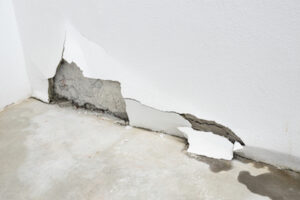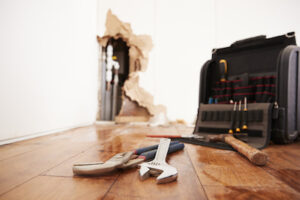Water Damage Checklist: The Steps You Should Take Next
Discovering water damage in your house can be upsetting, but knowing the proper steps to take next is the key to restoring your space. Navigating this process requires a thoughtful approach, from the initial shock to the eventual recovery.
This blog will guide you with interactive and well-researched insights, simplifying each step to ensure you’re informed and confident.
Whether understanding the source, safeguarding against electrical hazards, seeking professional assistance, or preparing to move back in. So, be ready to tackle water damage with knowledge and necessary actions. Your home’s journey from damage to restoration starts here.

Steps to Recover from Water Damage
Here are the steps you should take when there is water damage in your home:
1. Locate the Source
The first step is to pinpoint the source. Figure out if it is a leaky pipe, a worn-out roof, or another culprit. Knowing the basis will make communicating with water damage restoration experts easier.
2. Turn Off the Power
Immediately turn off the power after locating the water damage in your home. Additionally, make sure to protect your family from potential electrical hazards.
When water enters the walls, the risk of shorts and shocks increases. Locate your main electrical panel and switch off the power to prevent accidents.
3. Document the Damage
Take photographs or videos of the water-damaged areas. This documentation can be crucial for insurance claims and assessment purposes.
4. Contact Your Insurance Company
Notify your insurance company as soon as possible about the water damage. Provide them with the necessary details and documentation to initiate the claims process.
5. Mitigate Further Damage
If safe, start removing items from the affected area to prevent additional damage. Place plastic or wooden blocks under furniture legs to raise them off wet floors. Remove wet carpets and rugs and extract water if you can safely. Additionally, make sure to open windows and doors for ventilation and drying. As well as then use fans and dehumidifiers to promote proper air circulation and dehumidification to prevent mold growth.
6. Call for Professional Assistance
After taking the necessary steps, you should contact a specialist for help. After damage restoration experts step in, they bring in a wealth of knowledge to accurately assess the damage’s extent.
Further, they can apply tools and techniques to create tailored strategies. Also, according to water damage restoration experts, the beginning of it should be catered to instantly. It’s not entirely about immediate fixes – specialists dig deeper into identifying the underlying cause and restraining future water-related miseries.
Remember, the journey to restoring your home post-water damage is problematic. Navigating it hand-in-hand with professionals promises peace of mind.
As you connect with these experts, you’re addressing more than just the current situation but securing your property’s future. Their role is pivotal in the grand symphony of recovery, producing harmony between damage and renewal.
7. Moving Back Into the House
You must be careful and thorough when moving back into your house after dealing with water damage. The steps you take are essential to ensure your home is safe and comfortable again. After repairs, check everything to be sure the damage is fixed. We suggest double-checking all the switches to see if they are causing the spark. You can reduce the chances of an accident through this small security measure.
Also, look for any leftover water, mold, or problems with the structure. It might take time, but it’s worth it. Taking these steps helps you move back in with confidence, knowing that you’ve done everything to make your home an excellent place to live again.

Frequently Asked Questions (FAQs)
Q1: How do I know if I have water damage?
A1: Common signs of water damage include damp or discolored walls and ceilings, warped flooring, peeling paint or wallpaper, a musty odor, and visible mold growth. Unexplained spikes in water bills could also indicate a hidden leak.
Q2: Can I handle water damage cleanup on my own?
A2: Small, localized incidents of water damage can often be handled on your own. However, for larger and more extensive damage, it’s advisable to seek professional assistance. Water damage restoration experts have the tools, knowledge, and experience to effectively mitigate damage and prevent further issues like mold growth.
Q3: How can I prevent mold growth after water damage?
A3: Quick action is key to preventing mold growth. Properly drying out the affected areas within 24-48 hours can significantly reduce the risk of mold infestation. In cases of extensive water damage, it’s recommended to consult professionals who can assess the situation and take appropriate measures.
Q4: Will my insurance cover water damage?
A4: It depends on your insurance policy and the cause of the water damage. Sudden and accidental incidents like burst pipes or appliance leaks are often covered by standard homeowners’ insurance. However, damage from flooding or poor maintenance may require additional coverage.
Q5: What should I do if the water damage is caused by a natural disaster?
If your home is affected by water damage due to a natural disaster such as a flood or hurricane, prioritize your safety and evacuate if necessary. Contact emergency services and your insurance company as soon as it’s safe to do so. Document the damage and follow the steps mentioned in the checklist above.
Q6: How do professionals restore water-damaged items?
Water damage restoration professionals use a combination of techniques to salvage items. These may include drying, dehumidifying, cleaning, disinfecting, and specialized treatments to prevent mold and odors. Porous materials like carpets and upholstery may require more intensive cleaning or replacement.
Q7: Can I prevent water damage in the future?
While you can’t eliminate all risks, you can take steps to minimize the likelihood of water damage. Regularly inspect your property for leaks, maintain your plumbing and roof, ensure proper drainage around your home, and consider installing water detection devices that can alert you to leaks early.
Q8: How long does the water damage restoration process take?
The duration of the restoration process depends on the extent of the damage. Minor incidents may take a few days, while more severe cases can take several weeks. Swift action in the early stages can help expedite the process and prevent further damage.
In Conclusion
In the face of water damage, taking the proper steps is your road to recovery. By following the above steps, you can navigate the process more effectively and you can minimize its impact and restore your property. Remember that safety is paramount, and addressing water damage promptly can save you from more extensive issues down the line.
With these insights, you’re restoring your home and peace of mind. Water damage might be a challenge, but armed with the right steps, you’re prepared to overcome it. Your journey from damage to renewal begins with informed decisions, putting you back in control of your home’s well-being.
